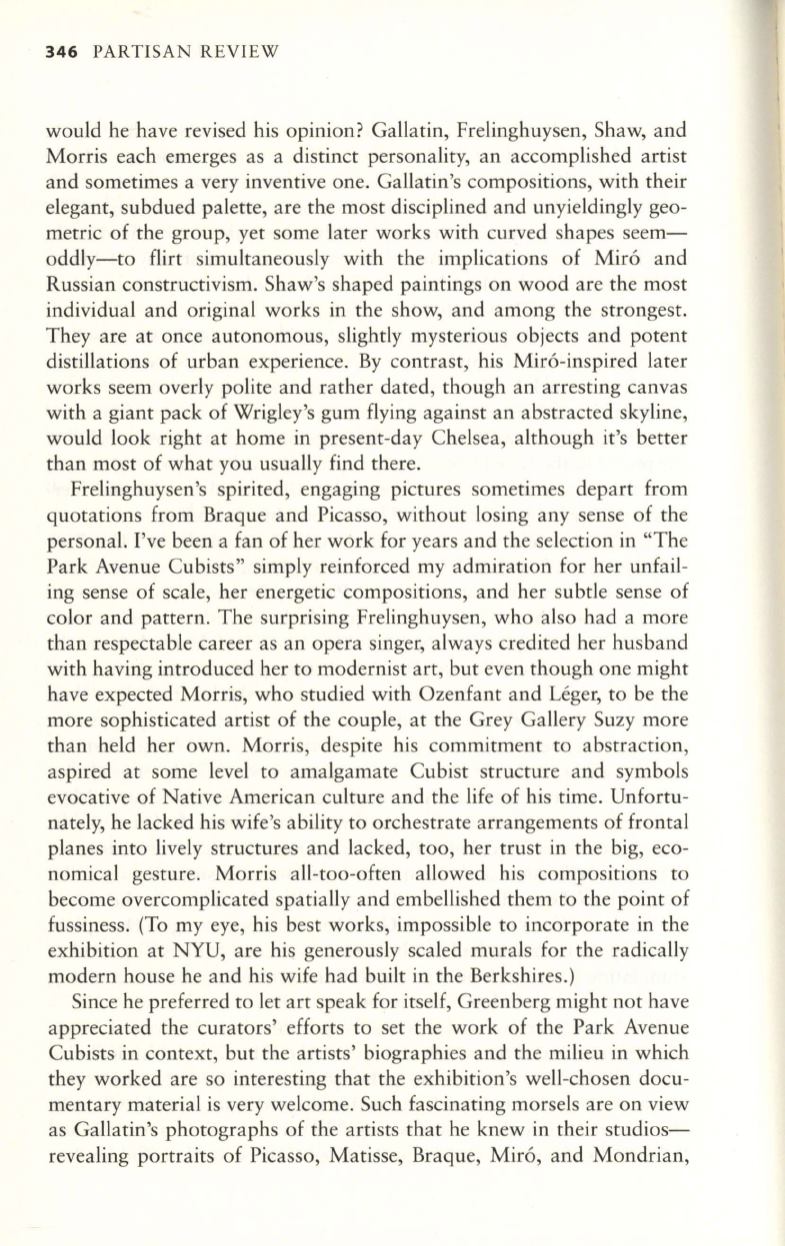
3 46
PARTISAN REVIEW
would he have revised his opinion? Gallatin, Frelinghuysen, Shaw, and
Morris each emerges as a distinct personality, an accomplished artist
and sometimes a very inventive one. Gallatin's compositions, with their
elegant, subdued palette, are the most disciplined and unyieldingly geo–
metric of the group, yet some later works with curved shapes seem–
oddly-to flirt simultaneously with the implications of Mira and
Russian constructivism. Shaw's shaped paintings on wood are the most
individual and original works in the show, and among the strongest.
They are at once autonomous, slightly mysterious objects and potent
distillations of urban experience. By contrast, his Mira-inspired later
works seem overly polite and rather dated, though an arresting canvas
with a giant pack of Wrigley's gum flying against an abstracted skyline,
would look right at home in present-day Chelsea, although it's better
than most of what you usually find there.
Frelinghuysen's spirited, engaging pictures sometimes depart from
quotations from Braque and Picasso, without losing any sense of the
personal. I've been a fan of her work for years and the selection in "The
Park Avenue Cubists" simply reinforced my admiration for her unfail–
ing sense of scale, her energetic compositions, and her subtle sense of
color and pattern. The surprising Frelinghuysen, who also had a more
than respectable career as an opera singer, always credited her husband
with having introduced her to modernist art, but even though one might
have expected Morris, who studied with Ozenfant and Leger, to be the
more sophisticated artist of the couple, at the Grey Gallery Suzy more
than held her own. Morris, despite his commitment to abstraction,
aspired at some level to amalgamate Cubist structure and symbols
evocative of Native American culture and the life of his time. Unfortu–
nately, he lacked his wife's ability to orchestrate arrangements of frontal
planes into lively structures and lacked, too, her trust in the big, eco–
nomical gesture. Morris all-too-often allowed his compositions to
become overcomplicated spatially and embellished them to the point of
fussiness. (To my eye, his best works, impossible to incorporate in the
exhibition at NYU, are his generously scaled murals for the radically
modern house he and his wife had built in the Berkshires.)
Since he preferred to let art speak for itself, Greenberg might not have
appreciated the curators' efforts to set the work of the Park Avenue
Cubists in context, but the artists' biographies and the milieu in which
they worked are so interesting that the exhibition's well-chosen docu–
mentary material is very welcome. Such fascinating morsels are on view
as Gallatin's photographs of the artists that he knew in their studios–
revealing portraits of Picasso, Matisse, Braque, Mira, and Mondrian,


